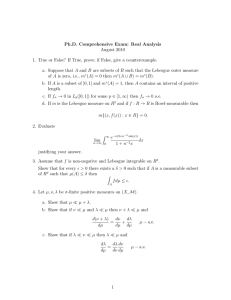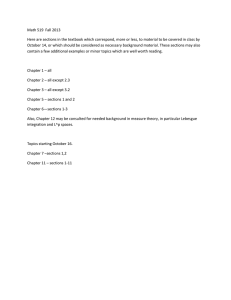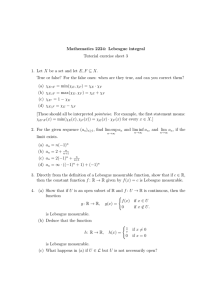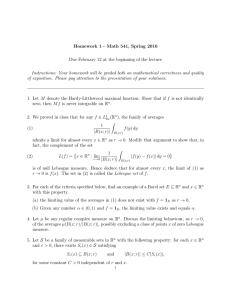Potential theory Potential measures
advertisement
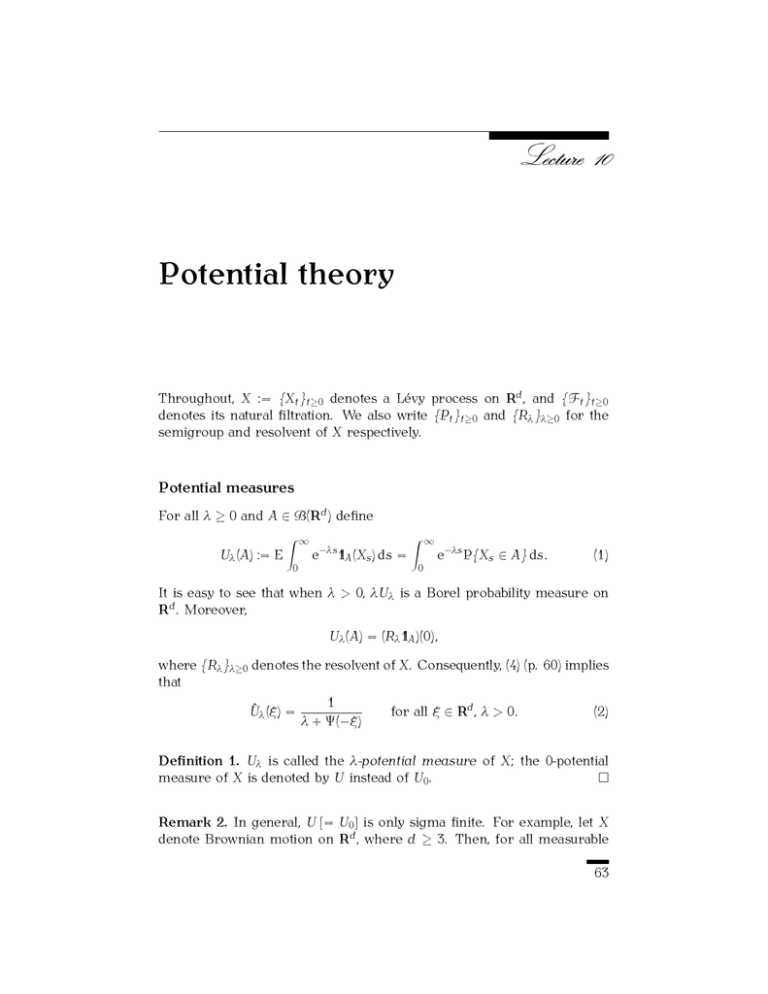
Potential theory
Throughout, X := {X� }�≥0 denotes a Lévy process on R� , and {�� }�≥0
denotes its natural filtration. We also write {P� }�≥0 and {Rλ }λ≥0 for the
semigroup and resolvent of X respectively.
Potential measures
For all λ ≥ 0 and A ∈ �(R� ) define
� ∞
�
−λ�
Uλ (A) := E
e 1lA (X� ) d� =
0
0
∞
e−λ� P{X� ∈ A} d��
(1)
It is easy to see that when λ > 0, λUλ is a Borel probability measure on
R� . Moreover,
Uλ (A) = (Rλ 1lA )(0)�
where {Rλ }λ≥0 denotes the resolvent of X. Consequently, (4) (p. 60) implies
that
1
Ûλ (ξ) =
for all ξ ∈ R� , λ > 0�
(2)
λ + Ψ(−ξ)
Definition 1. Uλ is called the λ-potential measure of X; the 0-potential
measure of X is denoted by U instead of U0 .
�
Remark 2. In general, U [= U0 ] is only sigma finite. For example, let X
denote Brownian motion on R� , where � ≥ 3. Then, for all measurable
63
64
10. Potential theory
functions � : R� → R+ ,
�
� ∞
� ∞ �
2
1
� dU = E
�(X� ) d� =
d�
d� �(�)e−��� /(2�)
�
(2π) 0
R�
0
R�
�
� ∞
�
2
�(�)
1
−��� /(2�)
d�
�(�)
d�
e
∝
d��
=
�
�−2
(2π) R�
0
R� ���
�
That is, U(A) ∝ A ���−�+2 d� when � ≥ 3; note that U(R� ) = ∞. When
� = 3, U(A) is the socalled “Newtonian potential” of A; and for general � ≥ 3
it is the “(� − 2)-dimensional Riesz potential of A.” The other λ-potentials
can be represented [in all dimensions] in terms of Bessel functions.
�
The range of a Lévy process
Define T(� � �) to be the first hitting time of B(� � �); i.e.,
T(� � �) := inf{� > 0 : X� ∈ B(� � �)}
(inf ∅ := ∞)�
Proposition 3. Uλ (A) > 0 for all open sets A ⊆ R� that contain the origin
and all λ ≥ 0. Moreover, for all � ∈ R� and λ� � > 0,
�
� U (B(� � 2�))
Uλ (B(� � �))
λ
≤ E e−λT(� ��) ; T(� � �) < ∞ ≤
�
Uλ (B(0 � 2�))
Uλ (B(0 � �))
Remark 4. Let τλ denote an independent Exp(λ) random variable; that is,
P{τλ > �} = e−λ� for � > 0. Then we can interpret the expectation in
Proposition 3 as follows:
�
�
E e−λT(� ��) ; T(� � �) < ∞ = P{T(� � �) < τλ }�
�∞
or equivalently, as the Laplace transform 0 e−λ� P{T(� � �) < �} d�.
�
Proof. We can write T in place of T(� � �), and note that: (i)
�� ∞
�
−λ(�+T)
Uλ (B(� � �)) = E
e
1lB(���) (X�+T − XT + XT ) d� ; T < ∞ ;
0
and (ii) �XT − �� ≤ � a.s. on {T < ∞} because X is cadlag. Therefore, the
strong Markov property tells us that
�� ∞
�
Uλ (B(� � �)) ≤ E
e−λ(�+T) 1lB(0�2�) (X�+T − XT ) d� ; T < ∞
� 0
�
= E e−λT ; T < ∞ · Uλ (B(0 � 2�))�
This implies the first inequality provided that we prove that Uλ (B(0 � �)) is
never zero; but that is easy. Indeed, the preceding display tells us that
sup�∈R� Uλ (B(� � �)) ≤ Uλ (B(0 � 2�)). Therefore, if Uλ (B(0 � �)) = 0 for some
The range of a Lévy process
65
� > 0, it follows that Uλ (B(� � �/2)) = 0 for all � ∈ R� . We can integrate
the latter λ-potential over all � to find that
�
�
�
�
0=
d�
Uλ (d�) 1lB(���/2) (�) =
Uλ (d�)
d� 1lB(���/2) (�)�
R�
R�
R�
R�
and this is impossible because the right-most term is simply the volume
of B(0 � �/2) times the total mass of Uλ [which is λ −1 ].
It remain to establish the second inequality. We continue to write T in
place of T(� � �), and note that
�� ∞
�
−λ(�+T)
Uλ (B(� � 2�)) ≥ E
e
1lB(��2�) (X�+T − XT + XT ) d� ; T < ∞
0
�� ∞
�
−λ(�+T)
≥E
e
1lB(���) (X�+T − XT ) d� ; T < ∞ �
0
because �XT � ≤ � a.s. on {T < ∞} and hence �XT+� − XT + XT � ≤
�X�+T − XT � + �XT � ≤ 2� a.s. on {�X�+T − XT � ≤ �}. Another application
of the strong Markov property does the job.
�
Proposition 3 has many uses; I mention one next.
Theorem 5 (Hawkes, 1986; Kesten, 1969). The following are equivalent:
(1) X(R+ ) a.s. has positive Lebesgue measure;
(2) Every Uλ is absolutely continuous with a bounded density;
(3) κ ∈ L1 (R� ), where
κ(ξ) := Re
�
1
1 + Ψ(ξ)
�
for all ξ ∈ R� �
Moreover, if κ �∈ L1 (R� ), then X(R+ ) has zero Lebesgue measure a.s.
Example 6. Let X be an isotropic stable process in R� with index α ∈ (0 � 2].
Then, the range of X has positive Lebesgue measure iff
�
� ∞ �−1
dξ
�
∝
d� < ∞
⇔
α > ��
α
1
+
�ξ�
1
+ �α
�
R
0
In particular, the range of planar Brownian motion has zero Lebesgue
measure [theorem of Lévy]. And the range of a one-dimensional isotropic
Cauchy process has zero Lebesgue measure as well. By contrast, let X be a
one-dimensional asymmetric Cauchy process, so that Ψ(ξ) = |ξ|+�θξ ln |ξ|,
for some θ ∈ [−2/π � 2/π]. Note that if X is asymmetric (i.e., θ �= 0), then
�
�
1
ReΨ(ξ)
1 + �(1)
Re
= 2
as |ξ| → ∞�
=
2
1 + Ψ(ξ)
|1 + Ψ(ξ)|
θ |ξ|(ln |ξ|)2
66
10. Potential theory
Therefore, while the range of the symmetric Cauchy process on the line
has zero Lebesgue measure, the range of an asymmetric Cauchy process
has positive Lebesgue measure.
�
Corollary 7. If X is a �-dimensional Lévy process where � ≥ 2, then
X(R+ ) has zero Lebesgue measure a.s.
Proof of Theorem 5. Let τλ denote an independent Exp(λ) random variable and apply Proposition 3 to find that
Uλ (B(� � �))
Uλ (B(� � 2�))
≤ P{T(� � �) < τλ } ≤
�
Uλ (B(0 � 2�))
Uλ (B(0 � �))
Note that T(� � �) < τλ if and only if X((0 � τλ )) ∩ B(� � �) �= ∅. Equivalently,
T(� � �) < τλ if and only if
�
�
� ∈ S(�) := � ∈ R� : dist(� � X((0 � τλ )) < � �
Consequently,
�
�
P {T(� � �) < τλ } d� =
R�
R�
P {� ∈ S(�)} d� = E
�
R�
1lS(�) (�) d� = E|S(�)|�
R�
d� 1lB(���) (�) =
where | · · · | denotes the Lebesgue measure. Also,
�
�
�
Uλ (B(� � �)) d� =
d�
Uλ (d�) 1lB(���) (�)
R�
R�
R�
�
�
=
Uλ (d�)
R�
�� �
�
λ
where � denotes the volume of a ball of radius one in R� . To summarize,
we obtain the following: For all � > 0,
�� �
2� �� �
≤ E|S(�)| ≤
λUλ (B(0 � 2�))
λUλ (B(0 � �))
for all � > 0�
Note that S(�) decreases to the closure of X((0 � τλ )) as � ↓ 0. Because
X is cadlag it has at most countably-many jumps. Therefore, the difference between X((0 � τλ )) and its closure is at most countable, hence has
zero Lebesgue measure. Therefore, the monotone convergence theorem
implies that
�
2� �
≤ E |X((0 � τλ ))| ≤
�
(3)
λLλ
λLλ
where
Uλ (B(0 � �))
Uλ (B(0 � �))
Lλ := lim inf
� Lλ := lim sup
�
�
�↓0
�
��
�↓0
Note that
� ∞
E|X((0 � τλ ))| = λ
e−λ� E|X((0 � �))| d��
0
The range of a Lévy process
67
[This can be obtained by conditioning first on X.] It follows from the monotonicity of � �� E|X((0 � �))| that E|X((0 � τλ ))| > 0 if and only if E|X((0 � �))| > 0
for all � > 0. And, in particular, E|X((0 � τλ ))| > 0 for some λ > 0 iff
E|X((0 � τλ ))| > 0 for all λ > 0. And this implies that Lλ < ∞ for some
λ > 0 iff Lλ < ∞ for all λ > 0 iff E|X(R+ )| = lim�↑∞ E|X((0 � �))| > 0.
Now we begin to prove the theorem.
Suppose |X(R+ )| > 0 a.s. Then, E|X(R+ )| > 0, whence Lλ < ∞ for
all λ > 0. Recall that Uλ (B(� � �)) ≤ Uλ (B(0 � 2�)), and that the latter is
O(� � ). Thus, Uλ (B(� � �)) ≤ const · |B(0 � �)| uniformly in � ∈ R� and � > 0,
whence it follows from a covering argument that Uλ (A) ≤ const · |A| for
all A ∈ �(R� ). In other words, (1)�(2).
Conversely, if (2) holds, then Lλ < ∞ and hence E|X(R+ )| > 0 by
(3). Choose and fix R > 0 so large that E|X((0 � R))| > 0. By the Markov
property, Z� := |X((�R � (� + 1)R])| are i.i.d. random variables (why?). Because |X(R+ )| ≥ sup�≥1 Z� , it follows from the Borel–Cantelli lemma for
independent events that |X(R+ )| ≥ E|X((0 � R))| > 0 a.s. Thus, (2)�(1). It
remains to prove the equivalence of (3) with (1) and (2).
The key computation is the following: For all uniformly-continuous
nonnegative φ ∈ L1 (R� ) such that φ̂ ≥ 0,
�
�
1
φ dU1 =
φ̂(ξ)κ(ξ) dξ�
(4)
(2π)� R�
R�
Let us first complete the proof of the theorem, assuming (4); and then we
establish (4).
Define, for every � > 0,
1
�� (�) :=
1lC(0��) (�)�
(2�)�
φ� (�) := (�� ∗ �� )(�)
for all � ∈ R� �
where C(0 � �) := {� ∈ R� : max1≤�≤� |�� | ≤ �} is a cube of side 2� about the
origin. One can check
directly that: (i) Every φ� is uniformly continuous
�
and in L1 (R� ); (ii) R� φ� (�) d� = 1 so that |φ̂� (ξ)| ≤ 1; and (iii) φ̂� (ξ) =
|�ˆ� (ξ)|2 ≥ 0. Moreover,
� � �
� � �
�
�
�
�
1 − cos(�ξ� )
1
1
��ξ
�
�ˆ� (ξ) =
e
d�
=
sin(�ξ
)
d�
=
�
�
�
�
�ξ�
(2�)
�
−�
0
�=1
�=1
�=1
Two applications of the triangle inequality show that
1
1
1lC(0��) (�) ≤ φ� (�) ≤
1lC(0�2�) (�)�
�
(4�)
(2�)�
Therefore,
Uλ (C(0 � �))
≤
(4�)�
�
φ� dUλ ≤
Uλ (C(0 � 2�))
�
(2�)�
68
10. Potential theory
√
By the triangle inequality, B(0 � �) ⊂ C(0 � �) and C(0 � 2�) ⊂� B(2 � �).
Therefore, it follows that Uλ has a bounded density iff lim sup�↓0 φ� dUλ <
�
�
∞ iff lim inf�↓0 φ� dUλ < ∞. If κ ∈ L1 (R� ), then R� φ̂� (ξ)κ(ξ) dξ →
�
R� κ(ξ) dξ as � ↓ 0, since φ̂� (ξ) is bounded uniformly in � and ξ, and
converges to 1 as � ↓ 0. Thus, (3)�(2). And conversely, if (2) holds, then
by (4) and Fatou’s lemma,
�
�
�
�
κ(ξ) dξ ≤ lim inf φ̂� (ξ)κ(ξ) dξ = (2π) lim inf φ� dU1
R�
�↓0
�↓0
≤ (2π)� lim inf
�↓0
U1 (C(0 � 2�))
< ∞�
(2�)�
It remains to verify the truth of (4). Indeed, we first note that the
left-hand side is (R1 φ)(0) so that whenever φ� φ̂ ∈ L1 (R� ),
�
� ∞
� ∞
�
φ dU1 = E
e−� φ(X� ) d� = E
e−� d�
dξ e−�ξ·X� φ̂(ξ)
R�
0
1
=
(2π)�
�
R�
0
R�
φ̂(ξ)
1
dξ =
1 + Ψ(−ξ)
(2π)�
This proves (4) for all nonnegative φ ∈
nonnegative.1
L1 (R� )
�
R�
φ̂(ξ)
dξ�
1 + Ψ(ξ)
such that φ̂ ∈ L1 (R� ) is
In order to prove (4) in full generality, suppose φ ∈ L1 (R� ) is uniformly
continuous and φ̂ ≥ 0, and let φ� denote the density of B� where B is
Brownian motion. Clearly, φ ∗ �� ∈ L1 (R� ), and its Fourier transform
is φ̂(ξ) exp(−��ξ�2 /2) is both nonnegative and in L1 (R� ). What we have
proved so far is enough to imply that (4) holds with φ replaced by φ ∗ �� ;
i.e.,
�
�
�
�
2
1
φ̂(ξ)
(φ ∗ �� ) dU1 =
Re
e−��ξ� /2 dξ
�
1
+
Ψ(−ξ)
�
�
(2π)
R
R
�
Now we let � ↓ 0; the left-hand side converges to φ dU1 by Fejer’s theorem; and the right-hand side converges to the right-hand side of (4) by
the monotone convergence theorem.
�
Proof of Corollary 7. Suppose there exists a Lévy process X on R� , with
� ≥ 2, whose range X(R+ ) has positive Lebesgue measure. �Let Ψ denote the Lévy exponent of X and apply Theorem 5 to find that R� Re(1 +
Ψ(ξ))−1 dξ < ∞. We will derive a contradiction from this.
Denote by (� � σ � �) the Lévy triple of X. Suppose first that σ is not
zero. Because σ is nonnegative definite we can find an orthogonal matrix
1If φ� φ̂ ∈ L1 (R� ) then the inversion formula holds. Therefore, φ is—up to a null set—uniformly
continuous. In fact, φ ∈ C0 (R� ) by the Riemann–Lebesgue lemma.
The range of a Lévy process
69
O and a diagonal matrix Λ of eigenvalues of σ such that σ = OΛO � . Let
λ1 ≤ · · · ≤ λ� denote the ordered eigenvalues of σ and suppose λ� is the
first first strictly positive eigenvalue of σ. Then,
�
�
�2 1 �
� � �2 λ� �
� � �2
1�
1 �
�√
� �
�
�
�(O ξ)� � �
ReΨ(ξ) ≥ ξ σξ = � Λ O ξ � =
λ� (O ξ)� ≥
2
2
2
2
�=1
In particular,
ReΨ(Oξ) ≥
�=�
λ�
λ�
�ξ�2 = �Oξ�2
4
4
for all ξ ∈ �� �
where �1 := R� and for all � = 2� � � � � �, �� is the cone
�−1
�
�
�
�� := � = (�1 � � � � � �� ) ∈ R� :
��2 ≤ 2
��2 �
�=1
�=�
Because ReΨ(ξ) ≥ 0, this shows that
�
�
1
ReΨ(Oξ)
ReΨ(Oξ)
λ�
�Oξ�2
Re
=
≥
≥
�
1 + Ψ(Oξ)
4 1 + |Ψ(Oξ)|2
|1 + Ψ(Oξ)|2
1 + |Ψ(Oξ)|2
and hence,
�
�
�Oξ�2
dξ
2
�� 1 + |Ψ(Oξ)|
�
dξ
≥ const ·
�
2
�� 1 + �ξ�
λ�
κ(ξ) dξ ≥
·
4
R�
since |Ψ(ξ)| ≤ const · (1 + �ξ�2 ). Integrate in spherical coordinates to find
that κ �∈ L1 (R� ). Theorem 5 tells us that |X(R+ )| = 0 a.s. in this case.
It remains to consider the case that σ = 0. But then |Ψ(ξ)| = �(�ξ�2 )
by Theorem 1 (page 34), and therefore,
�
�
√
X�
E exp �ξ · √
= e−�Ψ(ξ/ �) → 1
as � ↓ 0�
�
√
Therefore, X� / � → 0 in probability as � ↓ 0. But then
� ∞
� ∞
2
−λ�
2
Uλ (B(0 � �)) =
e P {�X� � ≤ �} d� = �
e−λ� � P {�X� 2 � � ≤ �} d��
0
0
Therefore, lim inf�↓0 � −� Uλ (B(0 � �)) = ∞ by Fatou’s lemma. Theorem 5
implies that |X(R+ )| = 0 a.s., and hence the result.
�
70
Problems for Lecture 10
10. Potential theory
Throughout, X is a Lévy process with exponent Ψ, and let P� (� � d�), P� , and Uλ
respectively denote the transition measures, semigroup, and λ-potential of X.
1. Suppose ρ is a Borel measure on R� . Choose and fix some finite � > 0. We
say that ρ is �-weakly unimodal if ρ(B(� � �)) ≤ �ρ(B(0 � 2�)) for all � > 0. Prove
that there exists a finite constant K := K(� � �), such that
ρ(B(� � 2�)) ≤ Kρ(B(0 � �))
for all � > 0�
Consequently, ρ(B(� � �)) ≤ Kρ(B(0 � �)) for all � > 0. Verify that U λ is �-weakly
unimodal for some � ∈ (0 � ∞) (Khoshnevisan and Xiao, 2003).
2. Suppose U(A � A) < ∞ and U(A) > 0, where U denotes the potential of X,
A ∈ �(R� ), and A � A := {� − � : �� � ∈ A}. Then prove that for all � > 0,
�∞
P {X� ∈ A � A} d�
�
sup P {� + X� ∈ A for some � ≥ �} ≤ �
U(A)
�
�∈R
In particular, sup�∈R� P{� + X� ∈ A for some � ≥ �} → 0 as � → ∞.

